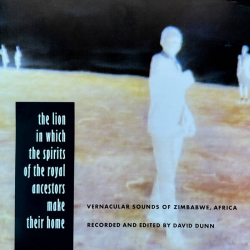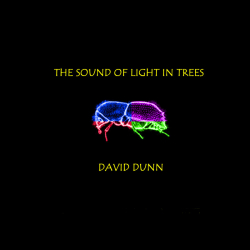Horseshoe Lake

Type
Audio/Visual
Authors
Dunn ( David Dunn )
Category
Album
[ Browse Items ]
Publication Year
2022
URL
[ private ]
Description
https://daviddunn.bandcamp.com/album/horseshoe-lake
Biblio Notes
HORSESHOE LAKE
A synchronized multi-frame audio field-recording at a large spatial scale.
BINAURAL RECORDING; PLEASE USE HEADPHONES
As an investigation into alternatives to the predominant assumptions of conventional audio recording, this project sought to explore how field-recording of very large outdoor acoustic environments might be achieved. This was accomplished through real-time multi-channel recording from multiple locations using several surround-microphone arrays, synchronized with wireless broadcast of conventional timecode. The resultant recording of extended sound-fields represents complex auditory networks that are otherwise impossible for normal human perception to experience. The conventional concept of a singular point of audition is entirely abandoned. Stated simply, conventional recording techniques can often compress temporal reality to conform spatial distance whereas, in this approach, we precisely synchronize temporal reality in order to compress large spatial distances.
On April 14, 2018, a moderately-sized lake (Horseshoe Lake) in the Santa Cruz Mountains, near La Honda, California, was recorded from six positions. The lake is roughly 0.5 miles in diameter. Although its shape vaguely reflects its name, it is fairly asymmetrical and nested within a mixed conifer and deciduous forest ecology. Most of the geological features extend out from the lake's flat terrain with a large hill extending upward from the inner dip of the horseshoe on one side of the lake. Two Zoom F8 recorders and four Zoom F4 recorders were used at the various microphone positions. The center 5.1 and binaural arrays were recorded using a F8 recorder that also served as the master for timecode broadcast. In addition to the center arrays, three ambisonic microphones, and two Double MS arrays were deployed. The recording began around 3pm and lasted 2hours and 15minutes. A wide variety of sounds were recorded during this timeframe including those of insects, various waterfowl, many other species of birds that were both stationary and in flight, amphibians, humans hiking the trail that surrounds the lake, and other anthropogenic sounds such as cars, motorcycles, aircraft, and an anonymous improvising violinist somewhere in the distant forest. Each microphone array picked up sounds that were shared by those positions close enough to a common sound source but also unique sounds not shared by other positions.
For this final recording, synchronized recordings from the six microphone arrays, situated across the lake’s half-mile diameter distance, were placed into a contrived binaural auditory field. The recordings from the original central positions were retained as the primary binaural reference placements. The other arrays were each collapsed to monophonic mixes with each “hard panned” separately to their corresponding spatial positions within the headphone playback stage (left to right). The resultant listening experience is akin to that of a singular listener with access to an impossibly wide auditory field (a quarter-mile in each direction) made apprehensible through a final binaural audio mix.
A central research assumption, banal by the standards of conventional stereo soundscape recording, was that none of the sounds captured by the recording process were to be edited. A conspicuous multi-dimensional and immersive depth is evident that takes on a kind of “holographic” presence beyond familiar surround sound strategies. The detailed, three-dimensional aural picture created by combining the individual array positions—when played simultaneously—presents several distinct phenomena that result in a number of disorienting deviations from how one “normally” perceives and makes sense of aural information.
The disorienting experience of hearing temporal resonances—splayed time delayed echoes from extremely separated individual sound sources—confounds normal expectations. It forces us to contend with multiplicities of perception that cannot otherwise simultaneously converge to our attention. There is a confusion of the cues we ordinarily use to perceive time and space. We become aware of many different simultaneous lengths of distance and many different simultaneous events in time. It is also a strategy for bringing these auditory anomalies—previously regarded as pejorative—to the foreground in order to acknowledge the profound perceptual challenges they represent. One implication is that this may be a rare situation where our cross-dimensional perception and experience of time and space become more symmetrical and inherently problematic. The novelty, complexity, and—in some ways—disorienting reality of the sound worlds represented by this process, appear to challenge our preconditioned habits for listening to audio reproductions and, possibly, aspects of the world at large.
A synchronized multi-frame audio field-recording at a large spatial scale.
BINAURAL RECORDING; PLEASE USE HEADPHONES
As an investigation into alternatives to the predominant assumptions of conventional audio recording, this project sought to explore how field-recording of very large outdoor acoustic environments might be achieved. This was accomplished through real-time multi-channel recording from multiple locations using several surround-microphone arrays, synchronized with wireless broadcast of conventional timecode. The resultant recording of extended sound-fields represents complex auditory networks that are otherwise impossible for normal human perception to experience. The conventional concept of a singular point of audition is entirely abandoned. Stated simply, conventional recording techniques can often compress temporal reality to conform spatial distance whereas, in this approach, we precisely synchronize temporal reality in order to compress large spatial distances.
On April 14, 2018, a moderately-sized lake (Horseshoe Lake) in the Santa Cruz Mountains, near La Honda, California, was recorded from six positions. The lake is roughly 0.5 miles in diameter. Although its shape vaguely reflects its name, it is fairly asymmetrical and nested within a mixed conifer and deciduous forest ecology. Most of the geological features extend out from the lake's flat terrain with a large hill extending upward from the inner dip of the horseshoe on one side of the lake. Two Zoom F8 recorders and four Zoom F4 recorders were used at the various microphone positions. The center 5.1 and binaural arrays were recorded using a F8 recorder that also served as the master for timecode broadcast. In addition to the center arrays, three ambisonic microphones, and two Double MS arrays were deployed. The recording began around 3pm and lasted 2hours and 15minutes. A wide variety of sounds were recorded during this timeframe including those of insects, various waterfowl, many other species of birds that were both stationary and in flight, amphibians, humans hiking the trail that surrounds the lake, and other anthropogenic sounds such as cars, motorcycles, aircraft, and an anonymous improvising violinist somewhere in the distant forest. Each microphone array picked up sounds that were shared by those positions close enough to a common sound source but also unique sounds not shared by other positions.
For this final recording, synchronized recordings from the six microphone arrays, situated across the lake’s half-mile diameter distance, were placed into a contrived binaural auditory field. The recordings from the original central positions were retained as the primary binaural reference placements. The other arrays were each collapsed to monophonic mixes with each “hard panned” separately to their corresponding spatial positions within the headphone playback stage (left to right). The resultant listening experience is akin to that of a singular listener with access to an impossibly wide auditory field (a quarter-mile in each direction) made apprehensible through a final binaural audio mix.
A central research assumption, banal by the standards of conventional stereo soundscape recording, was that none of the sounds captured by the recording process were to be edited. A conspicuous multi-dimensional and immersive depth is evident that takes on a kind of “holographic” presence beyond familiar surround sound strategies. The detailed, three-dimensional aural picture created by combining the individual array positions—when played simultaneously—presents several distinct phenomena that result in a number of disorienting deviations from how one “normally” perceives and makes sense of aural information.
The disorienting experience of hearing temporal resonances—splayed time delayed echoes from extremely separated individual sound sources—confounds normal expectations. It forces us to contend with multiplicities of perception that cannot otherwise simultaneously converge to our attention. There is a confusion of the cues we ordinarily use to perceive time and space. We become aware of many different simultaneous lengths of distance and many different simultaneous events in time. It is also a strategy for bringing these auditory anomalies—previously regarded as pejorative—to the foreground in order to acknowledge the profound perceptual challenges they represent. One implication is that this may be a rare situation where our cross-dimensional perception and experience of time and space become more symmetrical and inherently problematic. The novelty, complexity, and—in some ways—disorienting reality of the sound worlds represented by this process, appear to challenge our preconditioned habits for listening to audio reproductions and, possibly, aspects of the world at large.
Number of Copies
1
| Library | Accession No | Call No | Copy No | Edition | Location | Availability |
|---|---|---|---|---|---|---|
| Main | 601 | 1 | Yes |




